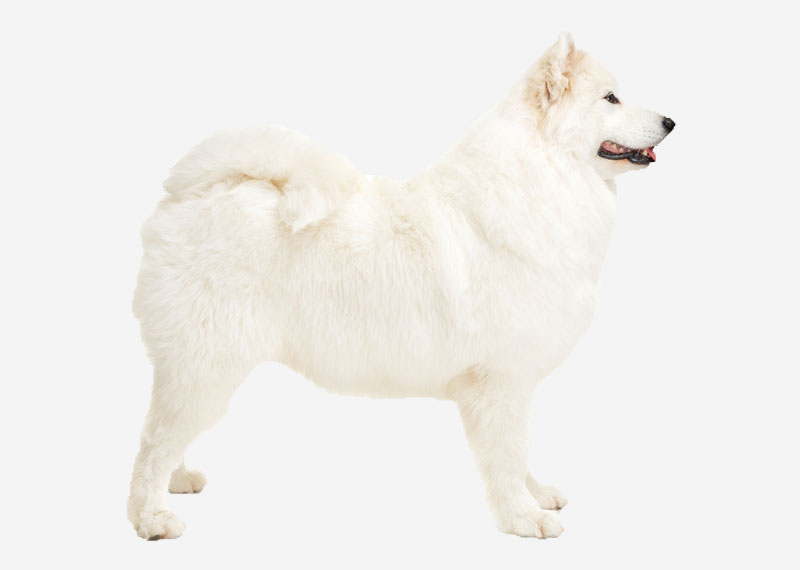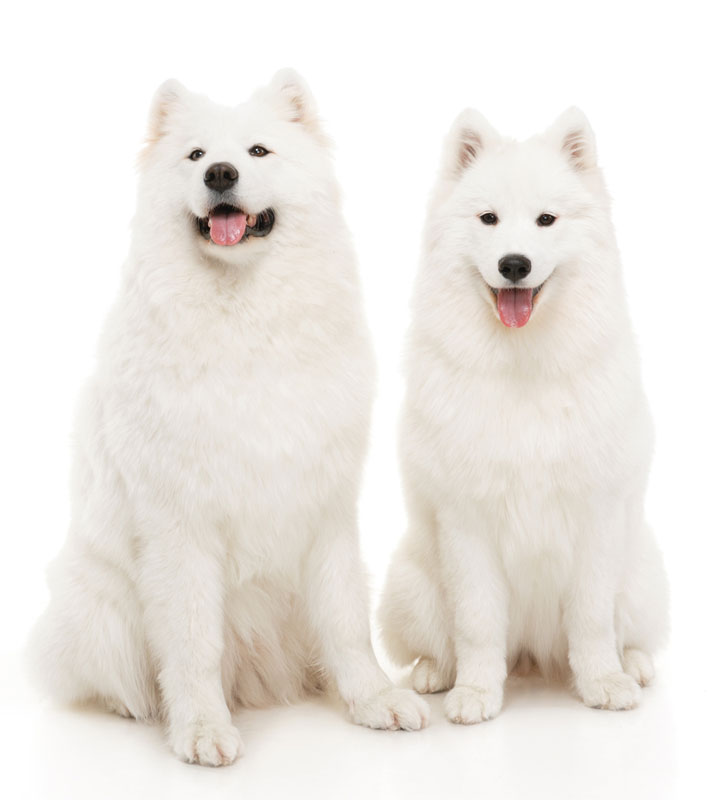The Samoyed (/ˈsæməjɛd/ SAM-ə-yed or /səˈmɔɪ.ɛd/ sə-MOY-ed; Russian: Самоедская собака) is a breed of dog that takes its name from the Samoyedic peoples of Siberia. These nomadic reindeer herders bred the fluffy white dogs to help with the herding, and to pull sleds when they moved. An alternate name for the breed, especially in Europe is Bjelkier.
Health
Genetic diversity
The Samoyed is a primitive dog belonging to the spitz or northern dog group, specifically the laikas: a Eurasian dog type used for a variety of purposes, namely hunting, herding, guarding, and sledding. The Samoyed is descended from the Nenets herding laika, a dog that comes in not only white, but also a wider variety of colors. Like many breeds, the Samoyed was bred from a small number of founders (in this case, from Siberia). The founder effect then led to a reduction in genetic diversity, which may explain why some Samoyeds today are affected by the genetic disorders below.
Samoyed Hereditary Glomerulopathy
Samoyeds can be affected by a genetic disease known as "Samoyed Hereditary Glomerulopathy", a renal disease. The disease is known to be caused by an X-linked dominant faulty allele and therefore the disease is more severe in male Samoyeds. Carrier females do develop mild symptoms after 2–3 months of age, but mostly do not go on to develop renal failure. The disease is caused by a defect in the structure of the type-IV collagen fibrils of the glomerular basement membrane. As a consequence, the collagen fibrils of the glomerular basement membrane are unable to form cross-links, so the structural integrity is weakened and the membrane is more susceptible to "wear-and-tear" damage. As the structure of the basement membrane begins to degenerate, plasma proteins are lost in the urine and symptoms begin to appear. Affected males appear healthy for the first 3 months of life, but then symptoms start to appear and worsen as the disease progresses: the dog becomes lethargic and muscle wastage occurs, as a result of proteinuria. From 3 months of age onwards, a reduced glomerular filtration rate is detected, indicative of progressive renal failure. Death from renal failure usually occurs by 15 months of age.
Also known as Hereditary nephritis, it is caused by a nonsense mutation in codon 1027 of the COL4A5 gene on the X chromosome (glycine to stop codon), which is similar to Alport's syndrome in humans. The disease is simply inherited X-linked dominant, with males generally having more severe symptoms than females. Clinically, proteinuria is found in both sexes from the age of three to four months; in dogs older than this, renal failure in combination with more or less pronounced hearing loss occurs swiftly and death at the age of 8 to 15 months is expected. In heterozygous females, the disease develops slowly. The disease can be treated to slow down the development by use of cyclosporine A and ACE inhibitors, but not be stopped.
If a carrier female is mated with a healthy stud dog, the female offspring have a 50% chance of being carriers for the disease, and any male offspring have a 50% chance of being affected by the disease. A genetic test is available for this disease.[10]
Other health concerns
For the Samoyeds in the veterinary literature several breed-specific hereditary diseases are described:
- Diabetes mellitus similar but not identical to human Type I (insulin deficiency): The disease occurs in middle-aged Samoyeds, the mean age at diagnosis is seven years. The cause is a chronic inflammation of the pancreas and / or autoimmune destruction of beta cells of islets of Langerhans. Moreover, in affected dogs autoantibodies were found to insulin. Currently, several genetic markers are discussed as possible causes.
- Progressive retinal atrophy (PRA) caused by a frameshift mutation in the RPRG locus of the X chromosome. The disease leads to a slowly progressive loss of vision, which eventually leads to blindness. The first symptoms appear between two and five years of age. The disease corresponds to the X-linked PRA type 3 in humans.
- Short legs in conjunction with eye abnormalities: Due to a genetic defect at the COL2A1 locus occurs on disproportionate dwarfism with short limbs in connection with cataracts, malformations of the retina and / or retinal detachment, liquefaction of the vitreous and a persistent hyaloid artery. The malformations of the retina are dominant (i.e. before coming in heterozygous dogs); the other symptoms are recessive, so they only come to expression in homozygous affected dogs. A connection with Opticin is not.
- Pulmonary stenosis occurs more frequently in Samoyeds in comparison with other breeds. The disease can cause shortness of breath, cardiac arrhythmias and tiring on motion and increases the risk of congestive heart failure.
- Hip dysplasia is also a concern for Samoyeds.
- The breed can also be affected by Sebaceous adenitis, an uncommon idiopathic autoimmune skin disease.
Life expectancy is about 12–13 years.
Famous Samoyeds
- Kaifas and Suggen, the lead dogs for Fridtjof Nansen's North Pole expedition.
- Etah, the lead dog for Roald Amundsen's expedition to the South Pole, the first to reach the pole.
- Samoyeds serve as the sled dogs of Stone Fox in the book of the same name.
- Xiah Junsu, member of South Korean boy band JYJ formerly from TVXQ, owns a Samoyed named Xiahky (which translates as "Raised by Xiah").
- Mush was the name of the Samoyed dog owned by Karen Carpenter of the popular music group The Carpenters.
- Denis Leary owned a Samoyed named "Little Bastard".
- Michelle Collins, star of British television soap operas EastEnders and Coronation Street owned a Samoyed called Jingle.
- Annabel Karmel (a British children's cookbook author) owns a Samoyed called "Hamilton".
- Sangchu is the name of the Samoyed in the 2012 Korean drama To The Beautiful You.
- King, the dog that appears in South Korean boy band EXO's 19th teaser with Lay, Baekhyun and Chen, is a Samoyed.
- Johnny is the name of the Samoyed owned by Academy Award winning Actress Helen Hunt.
- Soichiro is the name of Kyoko Otanashi's Samoyed in Maison Ikkoku.







